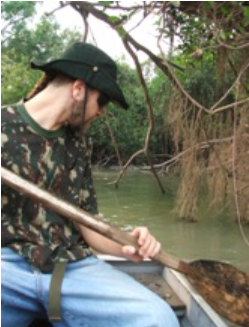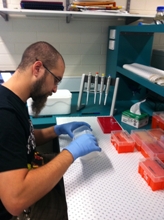PhD supervisors: Prof L Beheregaray and Prof G Colli (UNB, BRazil)
I have a Bachelor’s degree in Biological Sciences and a Master’s in Ecology, both by the University of Brasília (Brazil). I recently graduated from my PhD at the Molecular Ecology Lab at Flinders University. Before enrolling in my PhD I was lecturing in Brazil, which is one of my interests: the teaching of Evolution. Nowadays I am particularly interested in biogeography, phylogeography and systematics of Neotropical Herpetofauna.
Research Experience
I have been working on Herpetology since 2004, and developing projects with different approaches in this area. Below, there are some of the research projects that I have done or involved in; most of them are still on course:
– Comparative Phylogeography of Lizards from the Brazilian Cerrado: This is my PhD project, that aims to investigate biogeographic history in the Brazilian Cerrado using co-distributed lizards as a research subject. The phylogeographic analyses will be based on four lizard species: Gymnodactylus amarali (Phyllodactylidae), Micrablepharus atticolus (Gymnophtalmidae), Tropidurus itambere (Tropiduridae) and Anolis chrysolepis (Polychrotidae). These are species widely distributed in the Brazilian Cerrado and endemic to this biome. Please click here for more details.
– Geographical variation in the morphology of Gymnodactylus amarali: G. amarali is a Cerrado endemic gecko, usually found in rocks and termite nests. In my master project I described the geographic variation among the populations of this lizard and investigated how it was related to the climate and geography of Cerrado, and whether this variation could be due to adaptation.

– Cerrado Herpetofauna – Origins, Evolution and conservation: That’s a huge collaborative project, coordinated by Dr. Guarino Colli (University of Brasília – Brazil) in which I work as a collaborator. It has several people involved and the research is based on interpreting geographical distribution data of Cerrado reptiles and amphibians in order to generate information on endemism and richness, as well as to create past and recent models of distribution of the species. Beyond that, we are conducting biogeographic studies of some endemic species and other more widespread groups. All the results are being used to identify key conservation areas in this Biodiversity Hotspot.
– Biogeography of lizards in the Cerrado-Amazon transition: Another collaborative project, this one focuses in investigating biogeographic hypothesis of communities composition in the Cerrado-Amazon ecotone.
– Osteology of Microhylidae: The Brazilian Microhylidae frogs are fossorial and semi-fossorial animals that show different rates of morphological simplifications due to fossoriality. During my undergraduation I did detailed descriptions of some Brazilian Microhylidae genera, specially focusing in the loss and differentiation of bones from the pectoral girdle. The results have evolutionary and taxonomic implications.
